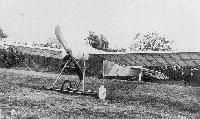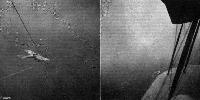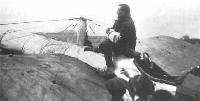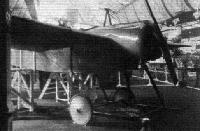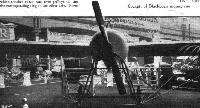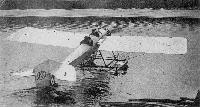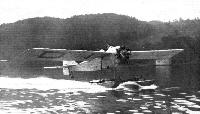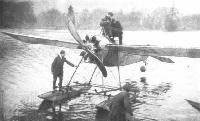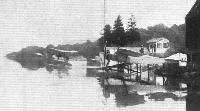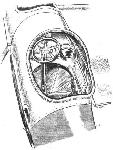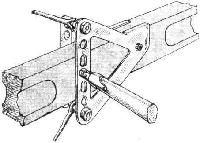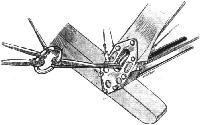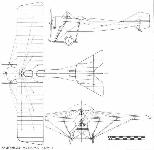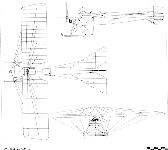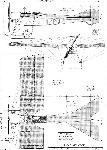A.Jackson Blackburn Aircraft since 1909 (Putnam)
Blackburn Type I
M. G. Christie, DSc, who had done some flying at Filey and Hendon on earlier Blackburn types but had not qualified for an Aviator's Certificate, watched the performance of Cyril Foggin's new single-seat monoplane with interest, having known the owner as a fellow pupil at Hendon. It came as no surprise therefore when he ordered a two-seat version and engaged Harold Blackburn to give flying demonstrations and to act as his personal pilot. Similar in appearance to, and structurally identical with, the single-seater, the new Blackburn Type I two-seater had the span increased to 38 ft and was fitted with the more powerful 80 hp Gnome generously cowled in aluminium for about five-eighths of its circumference and driving a 9 ft Blackburn laminated walnut airscrew. The occupants sat in tandem in a large double cockpit, with the passenger in front over the C.G. so that the aircraft could be flown solo from the rear seat without ballast. Instrumentation included a large Hewlett and Blondeau inclinometer mounted externally on the starboard wing pylon strut, and the control column, conforming for the first time to contemporary practice, moved fore and aft for elevator control and had a large steering wheel for wing warping. A slightly redesigned undercarriage with forward instead of backward, sloping front struts imparted a rakish appearance to the whole machine.
The Type I was delivered at the Yorkshire Aerodrome, Leeds, on 14 August 1913, and it is said that on its first test flight Harold Blackburn climbed it to 7,000 ft in 10 min. His flying programme, which commenced at Harrogate about a week later, usually took the form of a week or so's demonstration and joyriding at each town, followed by cross-country flights with M. G. Christie, the owner, at weekends. Typical of these trips was one made on 24 August 1913, from Bridlington to Leyburn (75 miles in 70 min) and then on via Ripon Racecourse to the Stray, Harrogate (40 miles in 23 min). Ripon was again visited on 10, 13 and 15 September - on the last occasion carrying Mrs Leigh, a local septuagenarian. Exhibition flying with steep turns took place at Doncaster and Wetherby on 20 and 21 September and a week or so later, on 2 October, Harold Blackburn secured the firm's first racing success by winning a challenge cup offered by the Yorkshire Evening News. In bad visibility and carrying Christie in the front seat, he groped his way to York, Doncaster, Sheffield, Barnsley, and back to Leeds in a 100-mile 'Wars of the Roses' air race against a Lancastrian entry in the shape of the Manchester-built Avro 504 prototype piloted by F. P. Raynham and carrying H. V. Roe as passenger.
After the 'Roses Race' the Type I monoplane was modified in two stages. To improve engine cooling and air supply to the carburettor, two large holes were cut in the nose cowling, and a hinged inspection panel was also provided, probably to facilitate engine priming. At the same time the inclinometer was removed and refitted internally and the inscription 'The Blackburn Aeroplane Co, Leeds. Type I' appeared on the rudder in bold capitals. In December 1913 the aircraft reached its final configuration when the large single cockpit was covered in by a sheet-metal decking to form two separate open cockpits with padded edges.
A second Type I monoplane which followed was a single-seater with a small freight compartment replacing the front cockpit, and a single vertical kingpost, encased in a wide-chord streamlined fairing, in place of the inverted V structure used for wing bracing on the previous machine. In this and two other respects it was a throw-back to the Blackburn Mercury since the cowling over the 80 hp Gnome was entirely open at the front, and it was controlled by means of the old 'triple steering column'.
Harold Blackburn flew it continually throughout the winter, and no better testimony to its strength and airworthiness can be found than the readiness with which he braved first fog and then gales in flying from York to Moortown, Leeds, in two attempts on 8-9 January 1914. An ovation from 10,000 spectators in pouring rain is a measure of the enthusiasm he generated, and from 29 March to 4 April he took part with this machine in a "Sheffield Aviation Week' organized by the Sheffield Independent and delivered copies of the early morning edition to Chesterfield on the last day. Passengers were also carried in Christie's Type I throughout the meeting. The 'single kingpost' machine was then exhibited at the Yorkshire Show but was damaged beyond repair in an accident at York later in 1914.
The success of these aircraft prompted the construction of a similar but somewhat improved two-seater which was the only monoplane of British design at the Aero Show which opened at Olympia on 16 March 1914. Then referred to as the Improved Type I, it differed significantly from its predecessors and can be distinguished from them quite easily in photographs. The 80 hp Gnome was more completely cowled and the engine bearers were modified to give a better nose shape in planform, while in side elevation the fuselage was noticeably deeper in the region of the undercarriage. The tailplane was cut back so that it did not extend forward of the fin, the tail skid consisted of two steel rods instead of one, and there were no wedge-shaped strengtheners where the front undercarriage struts were bolted to the skids. A small but useful identifying detail, not found on either of the other Type I machines, was a small brass engraved plate bolted to the nose cowling above the airscrew hub. Internally there were ash instead of Cottonwood flanges to the wing ribs. The aircraft type and the manufacturer's name were inscribed on the rudder, though less boldly than on Christie's machine.
On 18 April 1914, Harold Blackburn took the Christie Type I to Saltburn, and during the first week in June was at South Shore, Blackpool. On 22 July he opened the first scheduled service in Great Britain by flying in it with the Lady Mayoress of Leeds on the first of the day's every-half-hour runs between Leeds and Bradford. He also tried out his old adversary the prototype Avro 504 biplane, and at the end of the month, when at Southport, took delivery of one of the first four production Avro 504s, but his plans for a flying circus ended at Harrogate in the following month when war was declared and both machines were commandeered by the Government. Guarded by Guy Wilton, one of Blackburn's pupils, they remained inert until a few days later saboteurs (local German waiters were suspected) soaked them in petrol and set fire to their canvas hangar. Somehow Wilton got both aircraft out safely but was badly burned for his trouble.
The first flight of the Improved Type I went unrecorded, but it is known to have been flown at the Knavesmire aviation ground, York, on 9 July 1914 in the hands of the Australian pilot Sydney Pickles, who left next day for West Auckland with a passenger, two suitcases and a two gallon tin of castor oil for the engine. Fog forced him to land in a small field at Darlington and the flight was completed next day. After demonstration flights sponsored by the Yorkshire Post, the name of which was painted under the mainplane, he returned to York on 13 July where one of his passengers was R. W. Kenworthy, destined to be Blackburn's chief test pilot before the 1914-18 war was over. On 22 July he flew Col Brotherton, the Lord Mayor of Leeds, from Leeds to Bradford on the day that Harold Blackburn inaugurated his half-hourly service by conveying the Lady Mayoress.
On Sunday, 26 July, Pickles flew the Improved Type I the 32 miles back to Knavesmire in 18 min at an average speed of 105 mph, and when war broke out this machine was also commandeered. It was taken to Scarborough in September and housed in the hangar built for the Blackburn Type L seaplane (q.v.). Obviously it was of little military value and in the following year was acquired by the Northern Aircraft Co, successors to the Lakes Flying Co of Windermere, for whom Blackburns rebuilt it as a floatplane trainer. They fitted an uncowled 100 hp Anzani radial, enlarged the cockpit openings, installed dual control, removed the wheels and axle and clamped the skids to the float spreader bars with U shackles. A small cylindrical float was fitted at the tail. Reconversion to landplane was only a matter of a few minutes so that in this form the aircraft was known as the Land Sea monoplane. In actual fact the wheels were never re-fitted.
It was erected at Windermere by the Northern Aircraft Company and the first flight was made from the firm's slipway at Bowness by W. Rowland Ding on 26 October 1915. Despite the major engine change and the makeshift undercarriage, it needed no adjustments whatever although it was found expedient to remove the exhaust collector ring from the engine early in 1916. With Ding's name painted large on the underside of the mainplane, the aircraft was used for the initial training of a large number of RNAS pilots, and J. Lankester Parker, afterwards Short's famous test pilot, who also instructed on this aircraft, recorded an undated 2hr 39 min on it with pupils, as well as a climb, two up, to 4,050 ft in 31 min. On Saturday, 18 March 1916, he flew it from Windermere to Coniston Water and, although the trip took only a few minutes, climbed to 2,900 ft. The machine was tied up at Waterhcad Pier while the aviators lunched at a local hotel and on the return journey reached a height of 3,400 ft. It was the first seaplane to alight on Coniston where it attracted considerable attention, but a fortnight or so later on 1 April it capsized at Bowness and was written off.
Designs prepared in 1914 for a pure seaplane based on the Improved Type I were not proceeded with, probably because float drag and the 100 lb weight penalty would have made it underpowered with an 80 h p Gnome, the estimated maximum speed being a mere 60 mph.
SPECIFICATION AND DATA
Manufacturers: The Blackburn Aeroplane Co, Balm Road, Leeds, Yorks.
Power Plants:
(Type I) One 80 hp Gnome
(Improved Type I) One 80 hp Gnome
(Land Sea) One 100 hp Anzani
Dimensions:
Span 38 ft 0 in Length 28 ft 6 in
Length (seaplane) 29 ft 6 in Wing area 252 sq ft
Weights:
(Type I) Tare weight 950 lb All-up weight 1,500 lb
(Land Sea) Tare weight 1,124 lb All-up weight 1,733 lb
Performance:
Maximum speed (Type I) 70 mph (Land Sea) 82 mph
Initial climb 700 ft min. Endurance 4 hr
Production :
(a) Type I
Two aircraft only:
1. Two-seater for M. G. Christie, first flown August 1913.
2. Single-seater, with freight compartment, for Harold Blackburn first flown about December 1913, extensively damaged in accident at York about May 1914, stored.
(b) Improved Type I
One aircraft only:
Two-seater shown at Olympia, March 1914, commandeered September 1914, converted to Land Sea Monoplane 1915.
(c) Land Sea Monoplane
One aircraft only:
Conversion of the Improved Type I, first flown on floats at Bowness-on-Windermere 26 October 1915, capsized at Bowness and written off 1 April 1916.
Показать полностью
M.Goodall, A.Tagg British Aircraft before the Great War (Schiffer)
Deleted by request of (c)Schiffer Publishing
BLACKBURN monoplane Type I
This was the two-seater development of the 1912 machine with more power and the size increased to accommodate the passenger in the front cockpit. Three of the type were built, the first to the order of a private owner, with minor variations between each machine. There were visible differences to the engine cowlings, where cutaways were made to improve the cooling and air intake supply, and later when no cowling was fitted to the radial engine. One machine had a single kingpost and was a single-seater with freight compartment in place of the front cockpit. The original version had one large cockpit for both crew, but this was modified to make two separate cockpits.
The third machine was known as the 'Improved Type F, and this was later modified into a twin-float seaplane with tail float. This was known as the 'Land/Sea' monoplane since the main floats were clamped direct to the original undercarriage structure and the machine could readily be converted back for land use.
Type I. Two machines built
Power: 80hp Gnome seven-cylinder air-cooled rotary driving a 7ft diameter propeller.
No.1 Built for Dr. M.G. Christie as a two-seater and first flown on 14 August 1913 at the Yorkshire Aerodrome, Loft house Park, Leeds. It was used extensively until the outbreak of war, when it was commandeered, after which there is no record of its use.
No.2 This was a single-seater with freight compartment and single kingpost. First flown by Harold Blackburn on 14 December 1913. Damaged at York in May 1914. Acquired by W.R. Ding of the Northern Aircraft Co. and converted to a twin-float seaplane at Cockshot Point, Windermere. It was found to be unsatisfactory and not flown.
Improved Type I. One machine built
Power: 80hp Gnome seven-cylinder air-cooled rotary, later replaced by a 100hp Anzani ten-cylinder air-cooled radial when converted to Land/Seaplane. The only machine built was a two-seater shown at the Olympia Aero Show in March 1914. It was commandeered in September 1914 but, being of no military value, was returned to the makers. It was then sold to W.R. Ding of the Northern Aircraft Co. in 1915 as the Land/Sea monoplane. It was first flown on floats on 26 October 1915 at Bowness-on-Windermere, where it was used as a trainer until written off on 1 April 1916.
Data
Span 38ft
Chord 6ft 8in
Area 252 sq ft
Length 28ft 6in
Seaplane length 29ft 6in
Weight (Type I) 950 lb
Allup(Type I) 1,500 lb
Weight (Land/Sea) 1,124 lb
Allup (Land/Sea) 1,733 1b
Показать полностью
J.Bruce British Aeroplanes 1914-1918 (Putnam)
Blackburn Land/Sea Monoplane
THIS little Blackburn monoplane did not appear in the form illustrated until 1915, but it could trace its ancestry back to a two-seat monoplane landplane which was built in 1913. The 1913 aircraft was sold to Dr M. G. Christie, who did a good deal of flying in it, and it was also flown by Harold Blackburn (who was no relation to Robert Blackburn, the founder of the Blackburn company). In the hands of Harold Blackburn the monoplane won the aerial “War of the Roses”, a 100-mile inter-county race held on October 2nd, 1913, for a silver challenge cup presented by the Yorkshire Evening News.
A two-seater of similar design was used in 1914 for passenger flying, and may have been the Blackburn monoplane which was exhibited at the 1914 Olympia Aero Show. A seaplane version existed, originally powered by an 80 h.p. Gnome engine. Later a 100 h.p. Anzani radial was substituted, and in 1915 the aircraft was purchased by the Northern Aircraft Company. It was used by that concern as a seaplane trainer at Windermere, where it was flown extensively by W. Rowland Ding, and gave good service.
The aircraft’s transformation into a seaplane had been achieved simply: a pair of pontoon-type floats had been attached to the skid structure of the undercarriage in place of the axle and wheels of the landplane. The floats and wheels were in fact regarded as interchangeable; hence the aircraft was known as the Land/Sea Monoplane.
It was a simple aeroplane with a fabric-covered wooden structure. The fuselage had the triangular cross-section which had typified earlier Blackburn monoplanes, and there was a rounded top-decking. The mainplane was attached to the upper longerons, and was braced from above by wires from an inverted-vee cabane and from below by wires from the undercarriage. Lateral control was by wing-warping. The tail unit was wholly conventional, and incorporated a small tail float.
SPECIFICATION
Manufacturers: The Blackburn Aeroplane & Motor Co., Ltd., Olympia, Leeds, Yorkshire.
Power: 100 h.p. Anzani.
Dimensions: Span: 38 ft. Length: 28 ft 6 in.
Показать полностью
P.Lewis British Aircraft 1809-1914 (Putnam)
Blackburn I
During August, 1913, there appeared a two-seat version of the single-seat monoplane supplied to Cyril Foggin earlier in the year. The Type I, as it was called, was built for touring to the order of Dr. M. G. Christie. To carry the extra passenger, the span was increased by 5 ft. 11 ins. to 38 ft., the length being brought up to 28 ft. A corresponding increase in power was made with the installation of an 80 h.p. Gnome, which turned a 9 ft. propeller of Blackburn make. The favourite Blackburn triangular-section fuselage was constructed of wood and was sheeted with aluminium forward of the rear cockpit former.
The engine was almost completely cowled except for an opening in the lower portion, and this, together with the scuttle dash fitted, was designed to keep undesirable exhaust fumes and oil away from the occupants. Comfortable separate cockpits were installed, the passenger's seat being in front and over the centre of gravity, so that the machine could be flown from the rear cockpit solo or as a two-seater without alteration of balance. Warping of the parallel-chord wings was still used, and generous cut-outs at the rear roots gave a good view downwards from the pilot's seat. The same style of undercarriage was retained as that on the single-seater, springing being carried out by rubber cord over the axle.
On completion, the machine was tested by Harold Blackburn, who took it to 7,000 ft. in 10 mins. and established that it possessed a speed range of 40-70 m.p.h. Soon afterwards, the same pilot flew Dr. Christie on an extensive tour of Yorkshire towns during August and Septetnber, 1913. The following month, on 2nd October, Harold Blackburn and Dr. Christie raced the Type I against F. P. Raynham and H. V. Roe in the prototype Avro 504 biplane and upheld the name of Yorkshire to win the "War of the Roses" Challenge Cup presented by the Yorkshire Evening News for a contest over a course of 100 miles. The machine was flown intensively from the Lime of its debut, and by the end of 1913 had covered about 1,800 miles and had carried over 120 passengers.
At the Olympia Aero Show held in March, 1914, an improved Type I monoplane was exhibited on the Blackburn stand. Of the same size, and powered again by an 80 h.p. Gnome, the new version embodied modified engine bearers and a simplified, neater nose. The tandem seating arrangement was unaltered, but was arranged in a single cockpit without a bulkhead or decking between the pilot and passenger.
SPECIFICATION
Description: Two-seat high-wing tractor monoplane. Wooden structure, fabric covered.
Manufacturers: Blackburn Aeroplane Co., Balm Road, Leeds, Yorkshire.
Power Plant: 80 h.p. Gnome.
Dimensions: Span, 38 ft. Length, 28 ft. Wing area, 241 sq. ft.
Weights: Empty, 900 lb. Loaded, 1,500 lb.
Performance: Maximum speed, 70 m.p.h. Landing speed, 40 m.p.h.
Показать полностью
Jane's All The World Aircraft 1913
BLACKBURN Aeroplanes. Blackburn Aeroplane Co., Balm Road, Leeds. Blackburn produced his first machine early in 1910 (see 1911 edition for details). In the latter part of that year he designed the machine which ultimately developed into the Blackburn military. In 1911 other types were produced, all being fitted with the patent Blackburn triple control. School at Filey. Hucks has been the principal Blackburn flyer. The type has also been very successfully flown by naval officers. Capacity of works: about 24 a year.
1912-13 1912-13 1913.
Military. 2-seater. Military. 1-seater Hydro-biplane.
2-seater
Length.............. 32 feet (9.75 m.) 5 feet (7.60 m.) 33 feet (10 m.)
Span................ 40 feet (12.20 m.) 32 feet (9.75 m.) 44 & 36 ft
(13.4 & 11 m.)
Area ............... 276 sq.ft. (26 m?.) 195 sq.ft. (18 m?.) 410 sq.ft. (38 m?.)
Weight (total)...... ... 750 lbs. (340 kgs.) 1250 lbs. (507 kgs.)
Motor...........h.p. ... 50 Gnome. 80 Gnome or
100 Anzani
Speed............... 55-65 m. 60 m. (97 km.) 65 m. (105 km.)
(90-105 km.)
Notes.--Petrol for 5 hours (higher endurances can be fitted). Specially designed for military work--all steel construction. All parts unwelded to admit of rapid displacement. Clear observation provided for.
Fuselage.--The fuselage is V shaped and constructed of weldless steel tubing in the form of a lattice girder. The main longitudinals are of round section; cross members, oval section. Connections are not welded but made with strong steel clips so that should any member become damaged a new one can be readily arranged. The front portion is covered with sheet metal giving additional strength and reducing the head resistance. Stream line form tapering towards the rear which is covered with fabric.
Chassis.--Two long skids connected up to fuselage by metal struts. Each skid borne by a pair of wheels, axle held down by elastic shock absorbers. On the axle of the wheels are fitted steel springs which take side thrust. Each pair of wheels held by radius rods forming a bogie.
Control.--Patent Blackburn triple, independent or simultaneous on hand wheel, but special foot control for rudder is fitted if desired.
In 1912, five machines were built, of which two were of the mil. model. Others, non-military models (see last edition.)
Показать полностью
Журнал Flight
Flight, September 6, 1913.
Mr. Blackburn at Bridlington.
THROUGHOUT last week, Mr. Harold Blackburn was giving exhibition flights on his 80 h.p. Blackburn monoplane at Bridlington. Starting from Harrogate, where he had been flying for a few days, on the evening of Monday week, he flew with Dr. M. G. Christie to Bridlington, arriving in the twilight, being received by the Mayor. During the week he took up a number of passengers, and two of them were carried to Filey. Each day Blackburn was flying, and doing some fine banked turns over the bay. On Saturday, after taking up several passengers, he went with Dr. Christie over to Leyburn, a distance of about 75 miles, taking 70 mins. for the trip. Later the two journeyed by way of Ripon to Harrogate, where they landed on the Stray just as it was getting dusk. Flying with the wind this last trip of 40 miles was made in 23 mins. For the past two months Mr. Blackburn has been flying daily, and that the machine has been left out in the open without any protection from the weather speaks well for its sound construction.
Flight, September 20, 1913.
Harrogate to Bridlington and Back.
ON Monday last Mrs. Leigh, of Harrogate, had an exceptional experience in a trip on Mr. Harold Blackburn's monoplane from Harrogate to Bridlington and back, when the return journey was made at a very high speed owing to a terrific following wind, which enabled the distance to be covered in about 40 mins.
Flight, September 27, 1913.
Mr. Harold Blackburn at Harrogate, &c.
ON Monday, last week, Mr. Harold Blackburn, on the 80 h.p. Blackburn monoplane, left Ripon, where he had been giving exhibition flights during the week-end, for Harrogate, taking Dr. Christie, the owner of the machine, as passenger. They landed on the Stray at Harrogate, after doing the flight in 10 mins. at an altitude of about 2,000 ft. At 11.50 Monday morning, Mr. Blackburn started for a trip to Bridlington and back, with Mrs. Leigh as passenger. Mrs. Leigh, who is nearly 70 years of age, is probably one of the oldest ladies who has made such a long trip. They did the 65 miles to Bridlington in a little under the hour, having passed over York and Driffield and encircling the Bay before alighting. The return journey was started at 3.50 in the afternoon, and Harrogate reached 40 mins. afterwards.
The same evening Mr. Harold Blackburn took Dr. Christie up for a flight over the Stray, making some fine banked turns and spirals. On Thursday, Lt.-Gen. Broadwood went for a short passenger trip at Harrogate. They attained an altitude of 4,000 ft., and were flying for about a quarter of an hour. Later on Dr. Christie again accompanied Mr. Blackburn, when they did some fancy flying. Mr. Blackburn was again flying with Dr. Christie on the Friday.
On Saturday, Dr. Christie and Mr. Blackburn left Harrogate for Doncaster, where they arrived after a 40-min. flight. On Saturday afternoon Mr. Blackburn was giving exhibition and passenger flights, taking up seven different passengers during the course of the afternoon. On his first flight with Dr. Christie, he gave a very brilliant display of sharp banked turns, showing the wonderful control he has over the machine. After the exhibition they left just before dusk for Wetherby, where they were staying the night. The distance from Doncaster to Wetherby is about 30 miles. They returned to Doncaster on Sunday noon to give a further exhibition there. During the course of Sunday, about 12 passengers took trips in the machine.
Flight, October 11, 1913.
THE WAR OF THE ROSES.
A "WAR of the Roses" was fought out again last week in the form of a race between F. R. Raynham on an Avro biplane, which, of course, was built in Lancashire, and Harold Blackburn on a Blackburn monoplane, a Yorkshire product. The race, which was for a challenge cup offered by the Yorkshire Evening News, started and finished at Leeds, and was held over a circuit of which the chief points were York, Doncaster, Sheffield and Barnsley, a total distance of nearly 100 miles. To see the start about 60,000 people gathered on Moortown on Thursday of last week and both pilots got away from Leeds promptly at 2.14 p.m., Mr. Blackburn with Dr. Christie as passenger and Raynham accompanied by Mr. H. V. Roe. The weather was very bad, the mist making it very difficult to pick up the landmarks and keep on the course, in which respect Blackburn scored over his opponent, as he was more familiar with the country. It will be seen from our table that Raynham had an advantage by the time York was reached, and he was the first away again. At Doncaster, however, he was three seconds behind. Both men got away promptly from the Town Moor, Doncaster, and Blackburn still further improved his position, Raynham being handicapped by being unable to locate the control at Sheffield. He had to make two descents before reaching his destination, and he had the same trouble at the next control, Barnsley. In fact he flew right past it, and when he did descend it was at Dewsbury, some miles away. As it was then hopeless to try and put matters right, he flew direct to Leeds, and arrived some time before Blackburn. Soon after Blackburn's arrival the cup was presented to Dr. Christie, and handed by him to Blackburn. We understand that a return match will be held in Lancashire towards the end of the month, and it is anticipated that the event will become an annual one.
Blackburn. Raynham.
h. m. s. h. m. s.
Start 2 14 0 2 14 0
York arr. 2 39 48 1/5 2 38 59 2/5
,, dep. 3 1 28 4/5 3 0 40
Doncaster arr. 3 33 0 3 33 3
,, dep. 3 51 0 3 5' 3
Sheffield arr. 4 19 50 4 23 50
,, dep. 4 42 0 4 43 0
Barnsley arr. 4 55 23 3/5 -
,, dep. 5 19 0 -
Leeds finish 5 48 0 Disqualifie
Flight, December 27, 1913.
THE 80 H.P. BLACKBURN MONOPLANE.
ALTHOUGH the doings of the new Blackburn monoplane have not received such publicity as doubtlessly would have been the case had the flights been made in the neighbourhood of one of the well-known aerodromes, this machine has nevertheless done a considerable amount of flying in the north of England, and has, it is to be hoped, helped in no small measure to arouse the interest in aviation in that part of the country. A machine of this type, it will be remembered, was delivered to Dr. M. G. Christie in the middle of August and - piloted by Mr. Harold Blackburn - has been flying regulaêly since then, the distance traversed aggregating 1,800 miles, while over 120 passengers have been carried. It was this same machine which Mr. Blackburn flew with Dr. Christie as a passenger in the inter-county air race, for a distance of 100 miles, the Cup being won by Blackburn.
Constructionally this new machine differs considerably from the older type, and is a distinct advance on anything hitherto turned out by the Blackburn firm. The fuselage is streamline in shape and triangular in section, and is built up in the form of a lattice girder. The front part is of English ash, and is covered with sheet aluminium, giving it additional strength and reducing the head resistance. The engine is covered over for about five-eighths of its circumference by a beaten aluminium cowl, which is continued to form a scuttle dash. This effectively prevents the exhaust from the engine reaching either pilot or passenger.
The main planes are rectangular in form, and of a curvature designed to give maximum lift for a minimum drift. The main spars on which the ribs are built up are of the finest selected straight-grained English ash, the spars being machined out of the solid to the most efficient section, and not built up.
The webs are of silver spruce cut out to their true form and built up with cottonwood flanges, forming the ribs to which is attached the fabric. These ribs are strengthened by cottonwood distance pieces where pierced for spars, and are equally spaced by means of leading and trailing edge laths. The whole of the woodwork is well varnished before being covered with fabric, and is strongly braced internally to take the backward thrust imposed on the planes in flight. The planes are covered with finest quality fabric, which is fitted down with split cane beading.
The machine is supported on a very strong chassis composed of two long skids connected up to the fuselage by heavy ash struts. The skids and struts are of specially selected straight long-grained English ash, thoroughly seasoned and designed to withstand alighting on rough uneven ground. To the skids are attached a pair of wheels whose axle is held down by strong elastic shock absorbers, thus preventing shocks due to landing being transmitted to the main frame. The wheels are built up with specially wide hubs to resist any side thrust, and are streamlined with fabric.
The fabric with which the fuselage and planes are covered is very strong compared to its weight. It is carefully stretched on the framework, and is rendered oil- and water-proof by the application of a non-inflammable solution, which impregnates and tightens the fabric and gives a smooth and highly-polished surface.
The standard type of control is fitted, i.e., foot bar for operating rudder, to-and-fro motion of vertical column for operating elevators, and rotating handwheel for lateral balance. All control wires are duplicated.
An 80 h.p. Gnome engine is mounted in front of the fuselage, the supporting plates being of pressed steel. Engine controls are fitted on the right hand of the pilot's seat, and in a convenient position for rapid operation.
The seats for pilot and passenger are arranged in tandem, the passenger in front being situated over the C.G., thus enabling the machine to be flown either with or without a passenger without altering the balance.
For taking the weight of the machine in flight, each front spar is stayed to the chassis by three stranded cables. Three upper tie wires are attached to the front spar from the pylon. The breaking load of the upper wires is not less than two-thirds that of the lift wires. The three warping wires are attached to one main wire passing over pulleys on the rear chassis. The rear spar is, therefore, not bent when the wing is warped, but has an angular movement about the hinge on the fuselage; the corresponding top wires pass over a pulley on the pylon. All cables have a factor of safety of ten, and are spliced and bound with galvanised steel wire.
A Blackburn propeller of 9 feet diameter, built of specially selected laminated walnut, is coupled direct to the engine.
A lifting tail of 30 sq. feet area is fitted. Rudders and elevators are double surfaced.
The accommodation for both pilot and passenger is very comfortable, and a scuttle is fitted up to each seat which prevents the force of the wind from being uncomfortable on the pilot's and passenger's faces. The speed of the machine is 70 m.p.h., and the gross weight 1,500 lbs.
Flight, March 14, 1914.
WHAT THERE WILL BE TO SEE AT OLYMPIA.
THE EXHIBITS.
Blackburn (Blackburn Aeroplane Co.). (63.)
THE exhibit on this stand will consist of the 80 h.p. Gnome Blackburn monoplane, which has been specially built for high speed cross-country work. It will he of practically the same design of machine as was described in FLIGHT for December 27th last, when we noted that a similar machine had traversed a distance of 1,800 miles, and carried over 120 passengers during the preceding three months.
Every endeavour has been made in the design of this machine to reduce head resistance to a minimum, and to give the greatest comfort and safety to the pilot and passenger. The front part of the fuselage is covered in with sheet aluminium, and the engine is encased for about five-eighths of its circumference in an aluminium cowl, which is continued to the rear so as to form a scuttle dash, so that the exhaust or oil from the engine is prevented from blowing back upon the pilot or passenger, who are well screened from the wind. It is stated that the factor of safety used in the design of cables is not less than ten.
Flight, March 28, 1914.
THE OLYMPIA EXHIBITION.
THE EXHIBITS.
BLACKBURN (THE BLACKBURN AEROPLANE CO.).
THE monoplane exhibited by the Blackburn Aeroplane Co. is very similar to the machine sold to Dr. Christie, and fully described in our issue of December 27th, 1913. In the machine shown, no attempt has been made to piovide a very showy finish, but it is a thoroughly sound piece of work, and although it is by no means a particularly heavy machine, it gives the impression of being very strong.
Constructionally it follows fairly closely standard Blackburn practice, but the lines are now much more pleasing than were those of the earlier machines, and several detail improvements have been effected. The bearers for the engine - an 80 h.p. Gnome - have been modified, and the result is a much neater nose to the machine, whilst the engine bearers are probably as strong as were the old ones and certainly a good deal lighter. As before, the engine is mounted between double bearings, but the front bearer is formed in this machine by a horizontal U of channel steel continued along the front portion of the longerons. The engine is partly covered in by an aluminium shield, which prevents any oil from being blown back in the pilot's face.
The triangular section fuselage has been retained, and is built up of three longerons of ash and spruce with struts of the same material, whilst diagonal strips of wood forming a girder take the place of the usual internal cross wiring.
The pilot is accommodated in a very roomy and comfortable cockpit, and in front of him is the passenger's seat, in a separate cockpit. The old type Blackburn control has been replaced by one of a more standard type, consisting of a rotatable band wheel mounted on vertical column, which actuates the warp and elevator. The rudder is operated by a pivoted foot-bar.
The chassis consists of two stout ash skids supported on four vertical struts of the same material, and connected by two streamline steel tubes. The tubular axle is slung from the skids by rubber bands, and carries two wheels of the disc type.
The wings are built up of spruce webs wit h ash flanges over two ash spars of I section. The lift and drift is taken by heavy stranded cables running to the lower members of the chassis, and the warp cables, of which there are three, are secured to a very stout steel ring from which another cable runs over pulleys on the chassis to the corresponding ting on the other side. From the two rings the cable controlling the warp runs over pulleys to the control wheel. The upper bracing cables are secured to a pylon projecting above the fuselage covering. The front spars are secured in a strong wooden box forming a unit with the upper pylon, whilst the rear spars are hinged to the fuselage so that when the wings are warped the rear spar is not bent but simply swings round its pivot. The angle of the lift cables is particularly good owing to the comparatively high chassis which has always been one of the features of the Blackburn machines. The whole wing bracing system is immensely strong, and should inspire the pilot with absolute confidence.
Mounted on top of the fuselage is a stabilizing plane of roughly semi-circular shape to which is hinged the divided elevator. The rudder is hinged to a rudder post forming an extension of the stern post of the fuselage, and a small triangular vertical fin completes the tail unit. Mr. Blackburn is to be congratulated on the progress made during the last year or so. The machine as it stands now is thoroughly sound and quite equal to anything turned out by other monoplane constructors.
Various Blackburn propellers are also exhibited on this stand, and show that the Blackburn firm are able to turn out a highly finished article when they are so minded.
Flight, November 5, 1915.
EDDIES.
One of the latest additions to the fleet of the N.A.C. on Lake Windermere is a Blackburn monoplane with a 100 h.p. Anzani engine. In its general arrangement this machine is, as will be seen from the accompanying photograph, similar to the monoplane exhibited at the last Olympia Aero Show. The nose of the body is somewhat different, however, owing to the fitting of an Anzani engine instead of the Gnome used on the Show 'bus. The change from a land machine to a waterplane has been effected without any great alterations, the wheels and their axles being removed and two cross members substituted, from which the two floats are sprung by rubber bands. This machine arrived the other day, and was immediately erected. As soon as this was accomplished, Mr. Ding took it out for a trial run, and found it in perfect trim, needing no adjustments whatever. Another proof of Blackburn efficiency and thoroughness.
Показать полностью


